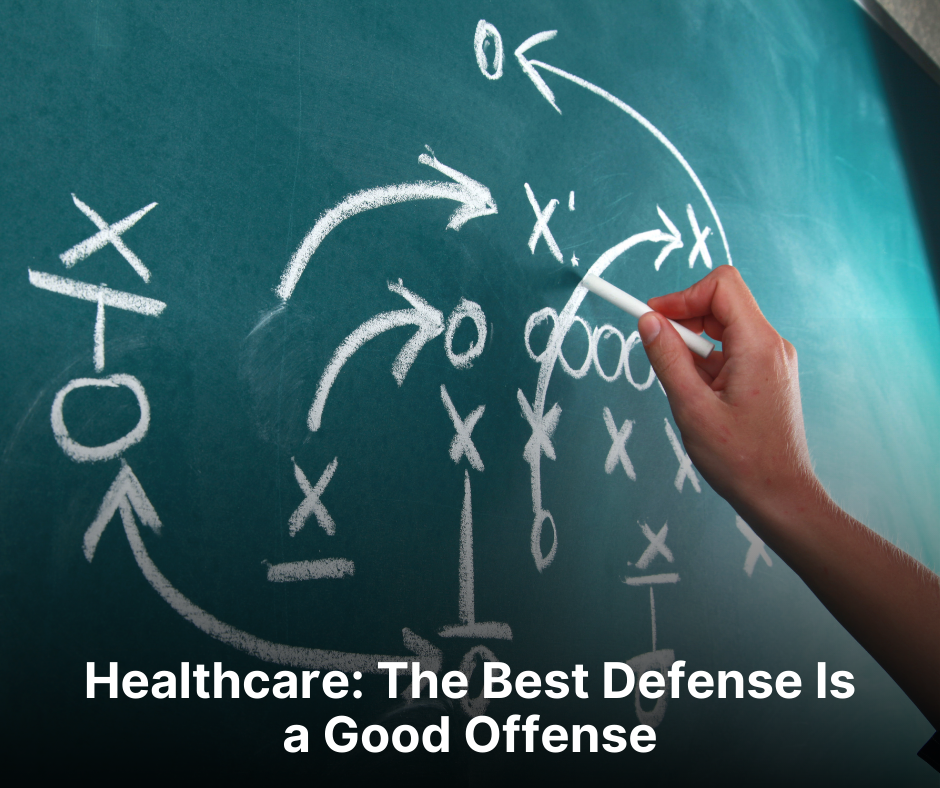Sports and Healthcare Investing Have a Lot in Common
Sports and healthcare investing may not seem to have much in common—until you consider the role that defense can play in both.
In football, for instance, teams that can prevent their opponents from scoring give themselves a better chance to win. This is how mantras such as “defense wins championships” and “the best offense is a good defense” came about.
So what does this have to do with healthcare investing? The healthcare sector is often characterized as “defensive,” and rightly so. Demand for pharmaceuticals and other medical products and services is less sensitive to downturns in the economic cycle and cutbacks in consumer spending.
As growth investors, we think the best defense is a good offense.
For this reason, we believe including healthcare stocks, along with other defensive sectors such as consumer staples and utilities, is a sensible way to diversify one’s portfolio and reduce portfolio volatility. But we don’t own healthcare stocks solely to diversify and reduce volatility—because as growth investors, we think the best defense is a good offense.
The best offenses in football, for example, typically have some combination of top-tier players and a top-notch strategy. We take a similar approach to investing. The individual companies in which we invest are the players and our top-down identification of key growth themes is our strategy.
Let’s start with the playbook or top-down strategy. We have discussed some of these opportunities—they even make up one of our growth themes—but they are worth revisiting as growth in these areas is continuing, if not accelerating.
Outsourcing to CROs and CDMOs
We are particularly enthused about a broad area that falls within the life science tools and services category, where we find many companies that are enabling innovative breakthroughs. More specifically, within this area we have identified what we believe is the long-term trend of biopharmaceutical outsourcing.
Increasingly, biopharmaceutical companies are outsourcing their research and development (R&D) and manufacturing to contract research organizations (CROs) and contract development and manufacturing organizations (CDMOs), adding a layer of growth potential on top of the consistent growth that we have seen in life science research spend year after year.
Gene Therapy Development
We also continue to see growth opportunities in the burgeoning market for cell and gene therapies, which are new modalities of medicine that find novel ways to treat patients with cancer and genetic disorders.
As I explained in another post, gene therapy is being investigated for use in sickle cell disease, hemophilia, muscular dystrophy, and even congenital deafness. And it’s potentially curative. You’re not just treating the symptoms; you’re addressing the underlying cause of a particular disease—a specific genetic defect.
The Rise of Telemedicine and Related Opportunities
Other growth themes in healthcare have either arisen or accelerated due to the COVID-19 pandemic. The most obvious was the rapid rise in adoption of telemedicine. Global lockdowns in 2020 accelerated a shift that would have otherwise moved more gradually.
While we don’t see telemedicine itself as a bastion of value creation, we do see many tangential areas of growth when we widen our lens in this area to encompass companies that are enabling digital adoption across the healthcare spectrum.
One example is companies that help pharmaceutical manufacturers use digital solutions to sell and market to doctors. Another is software companies making R&D organizations within leading life sciences firms more efficient.
Related Industries: Dental and Animal
We also see strong growth potential in health-related industries outside of the medical field, such as the dental and animal health industries. Ongoing demographic trends and rising spending on aesthetics support steady growth in the dental market, while demand for animal health products and services continues to benefit from increasing household spending on our pets.
Beyond those basic drivers of growth, innovation and digitalization (which are megatrends) also feature prominently as potential growth drivers in both the animal health and dental markets.
This may surprise some, as these industries are not necessarily regarded as highly innovative compared to other areas of healthcare. But individual companies are differentiating themselves from the competition in their ability to innovate with new products and/or adapt more business processes to a digital format—and these companies are disproportionately delivering outsized growth and returns.
We believe this is a perfect example of how some companies are winning by playing offense rather than defense.
Seeking Enduring Competitive Advantages
While the identification of growth themes is the first step in our investment process, we ultimately seek to invest in companies that also have distinct and enduring competitive advantages that can win in these growing markets and create compelling shareholder value over time. This is where having the right “players” can make all the difference.
Take the dental market as an example. We size the current global dental market at $28 billion, and we expect it to grow at a compound annual rate of 4% over the next five years. But within this steady-growth market, there are relative winners and losers, in both product categories and individual companies.
It is those companies with distinct competitive advantages that have all pulled away from the competition.
In terms of product categories, for example, certain dental procedures are becoming more commonplace and displacing other treatments. Dental implants are becoming increasingly common at the expense of crowns and bridges, for example, and clear aligners are overtaking wires and brackets.
But identifying those growth differentials is only step one of our investment process. If we’ve identified the growth opportunity, no doubt other industry participants have done so as well. Why then, do some companies succeed at tapping into new areas of growth while others struggle?
It is those companies with distinct competitive advantages—such as an ability to bring innovative new products to the market, an acute focus on customer needs, a strong brand, and a winning corporate culture—that have all pulled away from the competition and have delivered revenue growth rates far in excess of the dental industry’s stable, low-single-digit market growth
Building a Durable Team
When looking for the right “players,” we focus more on whether they possess these durable competitive advantages rather than whether they fit nicely into a well-defined and easily understood existing market.
For instance, one of our long-term holdings is a company that produces eyeglass lenses and other medical devices as well as niche information technology (IT) hardware components—components that can be used in the manufacturing of semiconductors and hard disk drives for data storage.
One of our long-term holdings is a company that produces eyeglass lenses and other medical devices as well as niche IT hardware components.
This might seem like an unlikely holding. After all, the end-markets for IT components are typically more cyclical and less predictable than the end-markets for healthcare. But we did not shy away from the growth opportunity, and the company has seen its IT components business perform better than anticipated.
Furthermore, over time we have come to better appreciate one of the company’s competitive advantages—expertise in manufacturing all sorts of optical components. This has enabled the company to take market share across both its medical and IT businesses, a trend that we think will continue.
Beyond the Horizon: AI
As we look further out and ask ourselves what healthcare may look like in 2030, we see many interesting opportunities.
Future areas of interest for us within healthcare include drug discovery enabled by artificial intelligence (AI), digital-first primary care models, advanced robotics in medical technology, synthetic biology, and gene editing, to name a few.
Given the accelerating level of innovation we are seeing across the medical field, we are hopeful that these opportunities keep lighting up the scoreboard.
About the Author: Tommy A. Sternberg, CFA, partner, is a global equity research analyst at William Blair. He covers large-cap healthcare companies. Previously, he was a research associate focused on the healthcare industry. Before joining William Blair in 2004, Sternberg spent two years as an equity analyst in Oak Brook Bank’s investment management and trust department. He is a member of the CFA Institute and the CFA Society Chicago. Sternberg received a bachelor's degree in economics from Duke University and an MBA from the University of Chicago’s Booth School of Business. William Blair is an Associate Advisor member of TEXPERS. Follow TEXPERS on Facebook, Twitter and LinkedIn as well as visit our website for the latest news about Texas' public pension industry.
Tommy A. Sternberg, CFA, partner, is a global equity research analyst at William Blair. He covers large-cap healthcare companies. Previously, he was a research associate focused on the healthcare industry. Before joining William Blair in 2004, Sternberg spent two years as an equity analyst in Oak Brook Bank’s investment management and trust department. He is a member of the CFA Institute and the CFA Society Chicago. Sternberg received a bachelor's degree in economics from Duke University and an MBA from the University of Chicago’s Booth School of Business. William Blair is an Associate Advisor member of TEXPERS. Follow TEXPERS on Facebook, Twitter and LinkedIn as well as visit our website for the latest news about Texas' public pension industry.


